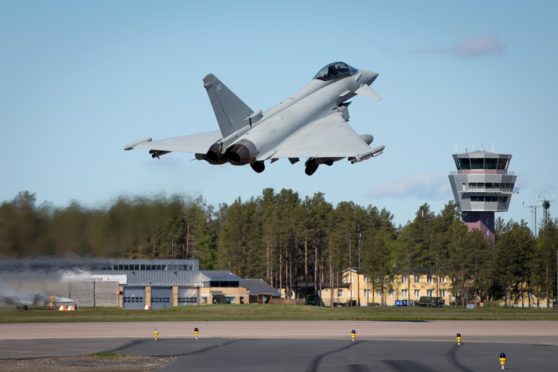Aircraft and personnel from RAF Lossiemouth took part in an Arctic training exercise described as one of the largest in Europe.
Typhoon pilots were joined by troops and planes from eight other NATO countries for the two-week long test of how effective the forces would be in a realistic threat environment.
Overall, 140 aircraft and 4,000 personnel gathered for Arctic Challenge Exercise (ACE), which took place across the airspaces of Sweden, Finland and Norway.
The RAF were located at the Lulea-Kallax air base in Sweden and contributed 155 personnel from 14 RAF stations to support its seven aircraft on the exercise.
Their craft included five Typhoon fast-jets, one Hercules tactical transport plane and one Voyager transport aircraft.
Corporal Tania Barr, 30, Logistics Mover from RAF Lossiemouth, enjoyed her time visiting the Scandinavian country.
She said: “It was interesting seeing how the Swedish work compared to us.
“They were really helpful in hosting us and everyone seemed to work really well together. I love going to new places and I’ve never been to Sweden.”
Each day had up to 100 aircraft fly simultaneously in the exercise area, where pilots from each nation took part in simulated scenarios to practice their combat air skills, alternating between playing the role of enemy and ally.
Seeing all those planes in the one place was a unique experience for one Typhoon pilot, Flight Lieutenant Craig Allison,
He said: “Getting to ‘fight’ against a Swedish Gripen jet was my favourite moment.
“It was good fun to see what we can do against each other and how differently we like to fly.
“We don’t often get to participate with 100 aircraft all airborne at the same time, so it was quite a unique experience.”
The RAF’s Typhoons flew alongside Swedish Gripens, F-18s from Finland and the US, F-16s from Norway, Denmark and the US and the Rafale and Mirage from France.
Wing Commander Matt D’Aubyn, commanding officer of the 6 Squadron in Lossiemouth, was also enthusiastic about the exercise.
He said: “ACE 19 was an opportunity for us to train with our allies to improve our interoperability and ensure we’re capable of contributing to the collective security of Europe and NATO.
“Flying alongside the pilots from other nations was great because there’s always that slight competition.
“You always want to prove yourselves and the UK contingent performed very well.”
